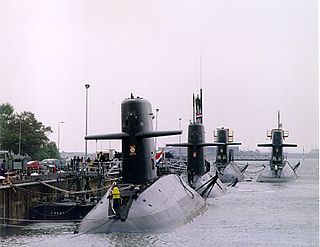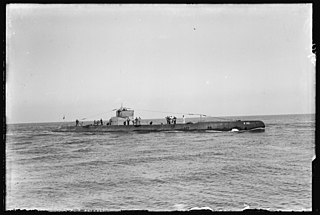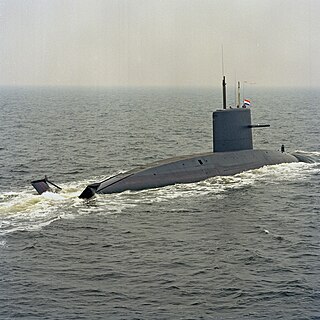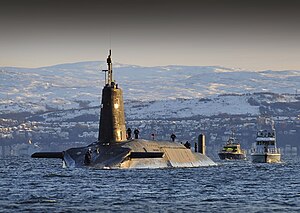
USS Icefish (SS-367), a Balao-class submarine, was a ship of the United States Navy named for the icefish, any member of the family Salangidae, small smeltlike fishes of China and Japan. These fish are also collectively known as whitebait.

The Walrus-class submarine is the only submarine class currently in operation in the Royal Netherlands Navy. The boats have been in service since 1990 and are all named after sea mammals.

HNLMS Walrus (S802) was a Walrus-class submarine of the Royal Netherlands Navy. After a long delay following a serious fire during construction, the submarine entered service in 1992. Walrus was deployed both for naval exercises and in combat operations around the world. She was decommissioned in October 2023.

The Zwaardvis-class submarine ("Swordfish") is a class of conventional attack submarines that were built to strengthen the Royal Netherlands Navy. The Dutch government opted for the choice to not replace the two Zwaardvis-class submarines with either more Walrus-class submarines, or submarines of a new design.

The Royal Navy Submarine Service is one of the five fighting arms of the Royal Navy. It is sometimes known as the Silent Service, as submarines are generally required to operate undetected.

HMS Tapir (P335) was a Second World War British T-class submarine, built by Vickers-Armstrong in Barrow-in-Furness. So far she has been the only ship of the Royal Navy to bear the name Tapir, after the animal.

HNLMS Zwaardvisch (S814) was the lead ship of the Royal Netherlands Navy's Zwaardvisch-class submarine, which was based on the British T class. The submarine was originally ordered as HMS Talent (P322) and built by Vickers Armstrong, Barrow. It served mainly in the Pacific against the Japanese during the war, operating under both British and US operational command in Ceylon and Australia. In 1950, the vessel was renamed HNLMS Zwaardvis. She was sold and broken up for scrap in 1963.

O 19, laid down as K XIX, was an O 19-class submarine of the Royal Netherlands Navy that saw service during World War II. O 19, along with her sister ship O 20, were the first submarines in the world to be equipped with a submarine snorkel that allowed the submarine to run its diesel engines while submerged.
O 15 was a O 12-class submarine of the Royal Netherlands Navy that saw service during World War II. It was the only submarine of the O 12 class built by Wilton-Fijenoord of Rotterdam. It was one of many Dutch ships doing convoy duty during the Spanish Civil War. When World War II broke out O 15 was stationed in Curaçao. It returned to Europe and was based in Dundee, whence it patrolled the coast of Norway and accompanied convoys to Archangelsk. The sub survived World War II and was taken out of active duty just after the Japanese surrender. It was demolished in 1946 in Hendrik-Ido-Ambacht.

O 13 was an O 12-class submarine of the Royal Netherlands Navy that saw service during World War II. She was built by the Koninklijke Maatschappij De Schelde of Vlissingen. She was one of many Dutch ships doing convoy duty during the Spanish Civil War. At the time of the German invasion of the Netherlands, O 13 was on patrol off the Dutch coast and was attacked by German planes on multiple occasions. After fleeing to England, the submarine was lost during a patrol on the North Sea.

O 1 was a Holland 7P patrol submarine of the Royal Netherlands Navy. The ship was built by the De Schelde shipyard in Flushing and was the first submarine in the Dutch navy. It had a diving depth of 25 metres.

The Zwaardvisch class was a class of initially two, and later four, submarines that served between 1943 and 1965 in the Royal Netherlands Navy (RNLN). They were former T-class submarines. Two were acquired and transferred to the RNLN during the Second World War, while another two were loaned from the Royal Navy post-war for a period of five years.

K I was a unique patrol submarine of the Royal Netherlands Navy. The ship was built by De Schelde shipyard in Flushing. The boat had a diving depth of 40 metres (130 ft).

O 21, laid down K XXI was an O 21-class submarine of the Royal Netherlands Navy that saw service during World War II. During the war she sank several ships, among them the German submarine U-95.
O 11 was a O 9-class patrol submarines of the Royal Netherlands Navy. The ship was built by Fijenoord shipyard in Rotterdam.
O 9 was an O 9-class patrol submarines of the Royal Netherlands Navy. The ship was built by Koninklijke Maatschappij De Schelde shipyard in Flushing.

K XII was a K XI class patrol submarines of the Royal Netherlands Navy. The ship was built by Fijenoord shipyard in Rotterdam.

HNLMS Zwaardvis (S806) was a Zwaardvis-class submarine of the Royal Netherlands Navy.

K XVIII was one of five K XIV-class submarines built for the Royal Netherlands Navy. She served during World War II.

HNLMS Zeeleeuw (S803) is a Walrus-class submarine of the Royal Netherlands Navy. She entered service in 1990 as the first submarine of the Walrus class, after the intended lead ship, HNLMS Walrus, was delayed for a long period following a serious fire during construction. Zeeleeuw has been deployed both for naval exercises and in combat operations around the world. Furthermore, the submarine plays an important role by performing intelligence operations. The submarine has undergone a mid-life maintenance and upgrade program between 2014 and 2016, and is currently in active service.
















